Onychoteuthidae
Hooked squids
K.S.R. Bolstad, Michael Vecchione, and Richard E. YoungThe family Onychoteuthidae was recently revised by Bolstad (2010), who recognized the following seven genera (with about 25 species).
- Onychoteuthis Lichtenstein, 1818
- Ancistroteuthis Gray, 1849
- Notonykia Nesis, Roeleveld & Nikitina, 1998
- Filippovia Bolstad, 2010
- Walvisteuthis Nesis & Nikitina 1986
- Onykia Lesueur, 1821
- Moroteuthopsis Pfeffer, 1900
Introduction
Onychoteuthids are small (ca. 7 cm ML) to large (ca. 2 m ML), muscular squids that have two series of smooth-ringed suckers on the arms and two series of hooks on the tentacular clubs (and, rarely, marginal suckers as well). Some species are common open ocean squids (e.g., Onychoteuthis spp.); others live near the ocean floor along continental or island slopes (bathyal region) (e.g., Onykia spp.).
Brief diagnosis:
An oegopsid ...- with buccal connectives attaching to ventral borders of arms IV.
- with simple, straight funnel-locking apparatus.
- with hooks on the tentacular clubs and two series of suckers on the arms.
- with rostrum on conus of gladius.
Characteristics
- Arms
- Arm suckers biserial with smooth rings.
- Hectocotylization absent.
- Arm suckers biserial with smooth rings.
- Tentacles
- Tentacular club with two medial series of hooks; ventromedial series with larger hooks.
- Marginal club suckers absent by subadult stages of most genera.
- Club suckers generally limited to carpal locking-apparatus and terminal pad in subadults, although a dactylus is present in Notonykia and possibly Kondakovia.
- Carpal locking apparatus with circular to oval shape that is usually defined by a ridge or elevation.
- Buccal crown
- Buccal connectives attach to ventral sides of Arms IV.
- Buccal connectives attach to ventral sides of Arms IV.
- Head
- Head with three primary (ventro-lateral) occipital folds in all genera; 3-8 secondary occipital folds also present in some genera (Onychoteuthis, Ancistroteuthis, Notonykia).
- Beaks
- Lower beak with a step following jaw angle.
 Click on an image to view larger version & data in a new window
Click on an image to view larger version & data in a new window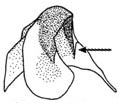
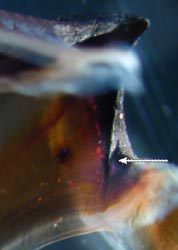
Figure. Anterior-oblique views of the lower beak. Arrows point to the step of both beaks. Left - Notonykia africanae, 100 mm ML, paratype. Modified from Nesis, et al., 1998. Right - Walvisteuthis virilis, mature male, NMNH specimen. The step ("angle ridge") lies just beyond the jaw angle where the rostral edge continues medially onto the lateral wall. That is, where the rostral edge merges into the lateral wall, the two are not flush along the medial beak surface. A well defined step is a characteristic feature of the lower beak of all members of the Onychoteuthidae. Such a step is seen outside the family only in Pholidoteuthis boschmai and to a lesser extent in some Enoploteuthis (Clarke, personal communication). Photograph by R. Young.
- Lower beak with a step following jaw angle.
- Funnel
- Funnel locking-apparatus with straight groove.
- Funnel locking-apparatus with straight groove.
- Photophores
- Photophores present only in Onychoteuthis and possibly Ancistroteuthis.
- Photophores present only in Onychoteuthis and possibly Ancistroteuthis.
- Gladius
- Gladius with primary conus.
- Gladius with rostrum, usually prominent.
Comments
The following table compares the major features that separate the genera (modified from Bolstad 2010).
| Genus | Photophores | Secondary occipital folds | Structure of mantle epidermis | Fins | Marginal suckers on manus | Terminal pad suckers | Rachidian |
|---|---|---|---|---|---|---|---|
| Onychoteuthis | Two intestinal*, one or two on each eye | Six to ten | Smooth | Rhombic | Absent at maturity | 9–18 | Variably unicuspid or tricuspid |
| Onykia | Absent | Absent | With warts* or longitudinal ridges | Rhombic to sagittate | Absent at maturity | 9–18 | Tricuspid |
| Ancistroteuthis | Absent1 | Six or seven | Smooth | Rhombic to sagittate | Absent at maturity | 15–19 | Tricuspid |
| Kondakovia | Absent | Absent | Longitudinally ridged or reticulate* | Heart-shaped* or rhombic | Full series present at maturity* | 30–36 | Unicuspid to weakly tricuspid |
| Notonykia | Absent | Three* | Smooth | Rhombic | One or two may remain distally at maturity | 17–25 (dactylus) + 11–14 (terminal pad) | Unicuspid |
| Filippovia | Absent | Absent | Smooth | Rhombic | Absent at maturity | 13–17 | Unicuspid |
| Callimachus | Absent | Absent | Smooth | Ovate or paddle-shaped in adults* | Proximal partial series present at maturity* | 8–11 | Tricuspid |
1 - Absent from mantle cavity; may be present on ventral surface of eye (nature of tissue undetermined)
* - indicates unique character within family
The following drawings illustrate the characters used in the table above.

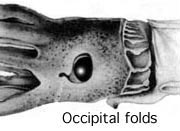
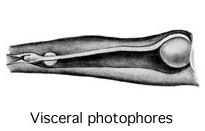
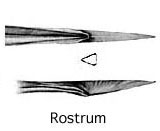
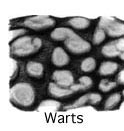

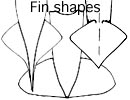
Top row:
- Occipital folds - Side view of the head of Onychoteuthis sp. Drawing modified from Pfeffer (1912).
- Visceral photophores - Ventral view, Onychoteuthis sp., off Florida. Drawing from Young (1972).
- Rostrum of gladius - Ventral and side views, Onykia ingens. Drawing modified from Pfeffer (1912).
Bottom row:
- Warts - Skin of Onykia ingens. Drawing modified from Pfeffer (1912).
- Marginal suckers - Oral view of tentacle club of Kondakovia longimana. drawing from Filippova (1972).
- Fin shapes: Left - Onykia robsoni, sagittate fins. Drawing modified from Kubodera et al. (1998). Middle - Callimachus rancureli, Oval fins. Drawing modified from Kubodera et al. (1998). Right - Kondakovia longimana, rhomboidal fins. Drawing modified from Filappova (1972).
Nomenclature
A list of all nominal genera and species in the Onychoteuthdae can be found here. The list includes the current status and type species of all genera, and the the current status, type repository and type locality of all species and all pertinent references.
Discussion of Phylogenetic Relationships
(Modified from Bolstad [2010]): Several studies have addressed genetic relationships within the Onychoteuthidae. Bonnaud et al. (1998) analysed 16S rRNA sequences from eight onychoteuthid species (from four genera). Notably, Callimachus youngorum (their ‘Onykia sp.’) appeared most closely related to the ‘Moroteuthis’ group—more closely related, in fact, than was F. knipovitchi, which until recently was also considered an Onykia species. Wakabayashi et al. (2007) conducted a similar study (using CO1) on nine onychoteuthid species from three genera. In their results, three Onykia species grouped closely together, with O. (M.) ingens slightly more distant; the Onychoteuthis species also grouped together; and F. knipovitchi did not fall out with the Onykia species, but rather the Onychoteuthis group.

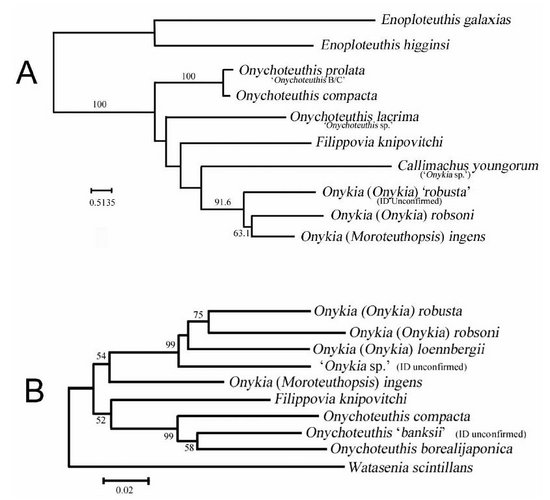
Figure. Summary of previous genetic studies on the Onychoteuthidae. A: ‘Tree obtained after neighbor-joining analysis of 16S sequences,’ modified from Bonnaud et al. (1998), fig. 6. B: ‘NJ tree of standard species and paralarvae’ (based on CO1 sequences), modified from Wakabayashi et al. (2007), fig. 2. Species names have been updated; where applicable, original species ID appears in smaller font following updated name. © (2010), Wakabayashi et al. (2007), Bonnaud et al. (1998).
Nesis (2000) assessed relationships within the family based on morphology and zoogeography, discussing primitive/advanced character states and likely phylogeny. He considered dense, muscular tissues, smooth skin on the mantle, and the absence of photophores and secondary occipital folds all to be primitive states, with ammoniacal tissues, sculptured skin, secondary occipital folds, and photophores representing more advanced states. Nesis also discussed the presence of both ‘primitive’ and ‘advanced’ genera in every zoogeographical zone (although he considered Onykia primitive and ‘Moroteuthis’ advanced, separating them based on the presence or absence of ammonium chloride (a bouyancy device) and concluded that the family evolved in the tropics.
Distribution
The family is absent from the Arctic Ocean but, otherwise, is found throughout the world's oceans (Nesis 1982/87).
References
Arkhipkin, A. I. and Ch. M. Nigmatullin. 1997. Ecology of the oceanic squid Onychoteuthis banksi and the relationship between the genera Onychoteuthis and Chaunoteuthis (Cephalopoda: Onychoteuthidae. J. Mar. Biol. Ass. U. K. 77:839-869.
Bolstad, K.S.R. 2010. Systematics of the Onychoteuthidae Gray, 1847 (Cephalopoda: Oegopsida). Zootaxa, 9626: 186 pp.
Bonnaud, L., P. G. Rodhouse and R. Boucher-Rodoni. 1998. A phylogenetic study of the squid family Onychoteuthidae (Cephalopoda: Oegopsida). Proc. R. Soc. Lond. B 265:1761-1770.
Kubodera, T., U. Piakowski, T. Okutani and M. R. Clarke. 1998. Taxonomy and zoogeography of the family Onychoteuthidae. Smithson. Contr. to Zool., No. 586 (vol. II):277-291.
Nesis, K. N. 1982/87. Abridged key to the cephalopod mollusks of the world's ocean. 385,ii pp. Light and Food Industry Publishing House, Moscow. (In Russian.). Translated into English by B. S. Levitov, ed. by L. A. Burgess (1987), Cephalopods of the world. T. F. H. Publications, Neptune City, NJ, 351pp.
Nesis, K.N. 2000. Squids of the family Onychoteuthidae: phylogeny, biogeography, and way of life. Zoologichesky Zhurnal, 79(3):272-281.
Nesis, K. N. and I. V. Nikitina. 1986. A new family of deepsea squids (Cephalopoda, Oegopsida) from the Southeastern Atlantic. Zool. Zhurn. 65: 47-54.
Nesis, K. N. and I. V. Nikitina 1992. New records of oceanic squids Walvisteuthis virilis Nesis et Nikitina, 1986 and Nototeuthis dimegacotyle Nesis et Nikitina, 1986 (Cephalopoda, Oegopsida) from the South Atlantic and the South Pacific. Ruthenica 2: 55-58.
Nesis, K. N., M. A. C. Roeleveld and I. V. Nikitina. 1998. A new genus and species of onychoteuthid squid from the Southern Ocean. Ruthenica 8:153-168.
Tsuchiya, K. and T. Okutani. 1991. Growth stages of Moroteuthis robusta (Verrill, 1881). Bull. Mar. Sci. 49:137-147.
Wakabayashi, T., Kubodera, T., Sakai, M., Ichii, T. & Chow, S. 2007. Molecular evidence for synonymy in the genera Moroteuthis and Onykia and identification of their paralarvae from northern Hawaiian waters. Journal of the Marine Biological Association of the United Kingdom, 87: 959–965.
Young, R. E. 1972. The systematics and areal distribution of pelagic cephalopods from the seas off Southern California. Smithson. Contr. Zool., 97: 1-159.
Title Illustrations

| Scientific Name | Onychoteuthis |
|---|---|
| Location | off Hawaii |
| View | side view |
| Image Use |
 This media file is licensed under the Creative Commons Attribution-NonCommercial License - Version 3.0. This media file is licensed under the Creative Commons Attribution-NonCommercial License - Version 3.0.
|
| Copyright |
© 1996

|
About This Page
K.S.R. Bolstad

Auckland University of Technology

National Museum of Natural History, Washington, D. C. , USA

University of Hawaii, Honolulu, HI, USA
Correspondence regarding this page should be directed to K.S.R. Bolstad at
Page copyright © 2019 K.S.R. Bolstad, , , and M. Vecchione, and
 Page: Tree of Life
Onychoteuthidae . Hooked squids.
Authored by
K.S.R. Bolstad, Michael Vecchione, and Richard E. Young.
The TEXT of this page is licensed under the
Creative Commons Attribution-NonCommercial License - Version 3.0. Note that images and other media
featured on this page are each governed by their own license, and they may or may not be available
for reuse. Click on an image or a media link to access the media data window, which provides the
relevant licensing information. For the general terms and conditions of ToL material reuse and
redistribution, please see the Tree of Life Copyright
Policies.
Page: Tree of Life
Onychoteuthidae . Hooked squids.
Authored by
K.S.R. Bolstad, Michael Vecchione, and Richard E. Young.
The TEXT of this page is licensed under the
Creative Commons Attribution-NonCommercial License - Version 3.0. Note that images and other media
featured on this page are each governed by their own license, and they may or may not be available
for reuse. Click on an image or a media link to access the media data window, which provides the
relevant licensing information. For the general terms and conditions of ToL material reuse and
redistribution, please see the Tree of Life Copyright
Policies.
- Content changed 26 March 2019
Citing this page:
Bolstad, K.S.R., Michael Vecchione, and Richard E. Young. 2019. Onychoteuthidae . Hooked squids. Version 26 March 2019. http://tolweb.org/Onychoteuthidae/19419/2019.03.26 in The Tree of Life Web Project, http://tolweb.org/





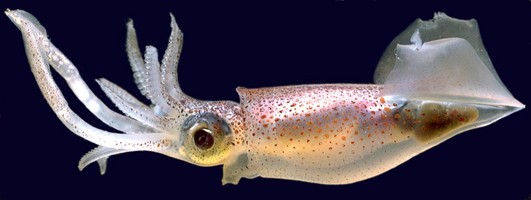

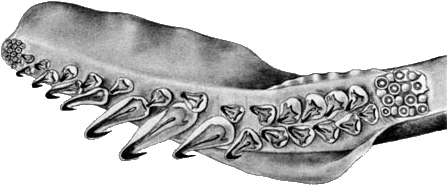




 Go to quick links
Go to quick search
Go to navigation for this section of the ToL site
Go to detailed links for the ToL site
Go to quick links
Go to quick search
Go to navigation for this section of the ToL site
Go to detailed links for the ToL site